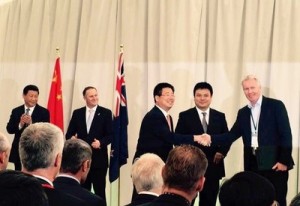KuangChi Science (HKSE: 00439) is collaborating with Airways New Zealand and Pengxin International to launch a ‘near space ship’ called Traveller in New Zealand.
KuangChi Science is a Hong Kong listed company specializing in novel space service.
 A MOU to launch the Traveller was included in the Witnessed Exchange of Commercial Documents, before President Xi Jinping of China and Prime Minister John Key, which featured at the Agri-tech Innovation Showcase at Auckland on Nov.21, 2014.
A MOU to launch the Traveller was included in the Witnessed Exchange of Commercial Documents, before President Xi Jinping of China and Prime Minister John Key, which featured at the Agri-tech Innovation Showcase at Auckland on Nov.21, 2014.
The MOU will see KuangChi Science collaborate with Airways and Pengxin in the refinement and launch of a huge near space balloon in New Zealand in the first half of next year. Airways New Zealand will support the launch by its experience assisting these launches and Pengxin will provide the launch site.
Known as the Traveler, the giant approximately 40 metre diameter, 1 tonne helium filled balloon, floats in what’s known as ‘near space’ which lies between 20 to 100km above sea level – twice the height flown by commercial airlines. The rarified atmosphere is devoid of turbulence, has low air pressure and temperature and is an area of space which has, until now, not been fully explored. The balloon construction is subject to a number of novel patents.
In 2013 Google launched 30 balloons in New Zealand. Spain, the USA and Japan have also been involved in similar projects. The Traveler has significant advantages to previous balloons, enabling it to carry greater and more diverse payloads.
Dr. Zhang Yangyang, CEO of KuangChi Science, said the balloons have the potential to deliver the internet to billions of people around the world who currently have no access, and at a moderate cost.
“It’s a fascinating concept that has a number of potential applications, the most obvious being Wi-Fi access. A number of other applications have also been suggested ranging from resource mapping, traffic control, shipping communications and disaster relief through to Search and Rescue activities.
“The balloons, which are equipped with transponders and fail-safe systems so their movement and altitude can be tracked and managed, provide a similar service to satellites but at a fraction of the cost.”The balloons remain in near space with self-generated solar power and are capable of recovery and task reloading.”
The site for the New Zealand launch is as yet to be determined.
“Obviously there are a lot of logistical and aeronautical issues which need to be addressed before the launch which is why we are grateful for the support and advice of Airways New Zealand,” Dr. Zhang Yangyang said.


